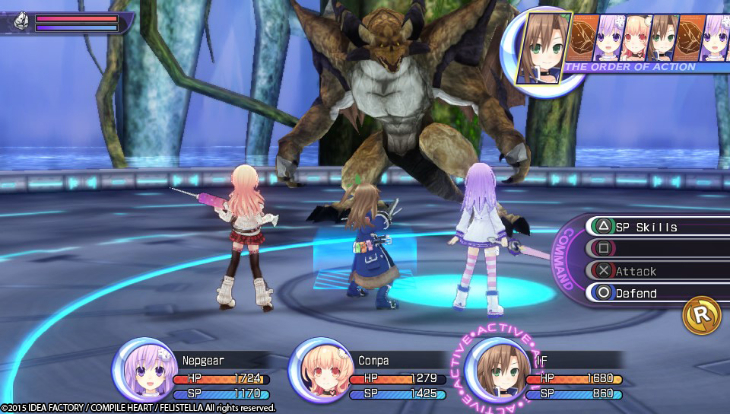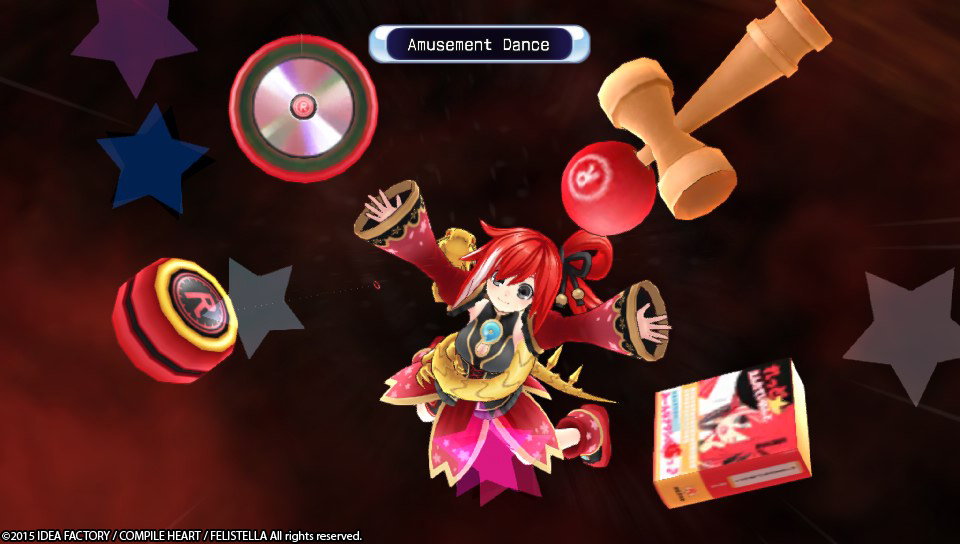The PS Vita has become the portable console of the moment, with so many titles coming especially from Japan to the handheld upping the roster quite drastically. Most of these Japanese games are in the form of Role Playing Games, for which the country is especially famous. One such series of games is Hyperdimension Neptunia, featuring an incredibly long title which may even discourage some before even buying the game.
Its full name being Hyperdimension Neptunia Re;Birth 2 Sister’s Generation, I would not be surprised to hear of someone being actually put off by the name since it sounds quite bombastic, but the game itself is quite worth it. Hyperdimension tells the tale of a gang of girls led by Nepgear, a violet haired warrior who is trapped in the beginning of the game from a malevolent force. This evil organisation is called ASIC, the Arfoire Syndicate of International Crime, and aims to bring back to life Arfoire, the deity of sin. Nepgear is then released from her friends IF and Compa, which are really the studios working on the game, IF being Idea Factory and Compa being Compile Heart. While not having an effect on the game, it is a nice touch to have names which directly represent the developers of the game, as if they were playing with you and trying to help your experience. The main aim of the game is to regain Shares for the CPUs and thus reduce the power of ASIC, and for this aim a statistic showing the shares held by each region is shown when in the world map. There are four regions across the world being Planeptune, Leanbox, Lastation and Lowee and then ASIC being the fifth party, which starts with the majority of shares and thus has all the power.
Shares can be earned by completing quests for each region’s guild, and typically involve killing a set number of enemies or collecting specific items. These can be retrieved by exploring the dungeons scattered around the map, where the instances of platforming take place. The platforming in the game is rather straightforward, with the only commands being moving in any direction, jumping and attacking, as well as a wave which detects treasures nearby. The only command which is useful apart from moving is the attack command, which can initiate a battle against the monsters roaming the area. If you connect with the attack, this is called a Symbol attack and will give you the first turns in battle, while if the enemy comes from behind the first turn is played by them. When the gap between your party and the target of the symbol attack is quite large, the enemy is killed instantly without any battle sequence going on.
The combat system is the main element of gameplay in Hyperdimension Neptunia and while at first it may seem a bit complicated due to the number of tutorials which pop up, it becomes quite manageable once you get the hang of things. Basically, this is a turn-based combat system with the character able to move about freely when it is his turn to play. Options such as attack, items or skills are available to choose from, and while most of the options are straight forward, the attack option features another system in itself. Upon choosing the normal attack option, the characters will have three different actions which can be selected, called combo chains. These chains are made up of three attack types, if you will, being Rush, Power and Break. The Rush attacks pack the least powerful of the three but features a number of hits in one move. The Power is the most powerful of the three, while the Break is the most effective in decreasing enemy shields. Combining the three in the game menu is not difficult and with the tutorials at hand it will not prove to be a lengthy task, although to slot a good combo while keeping with the CP limit will require a bit of thought, at least at first. Later on the Rush attacks will prove to be helpful in building the EX Finishers bars, finishing moves at the end of a combo, which require a bar to be filled up. This bar is filled through dealing or receiving damage, and Rush attacks are more effective in filling the bar, thus opting for a “weaker” solution while building up combos can result in having more damage at the end due to the finisher move. As different members join and leave the party they bring their own abilities to the fray, which can alter the style of play, for example having a strong character up front while the others can support from the back. This is also implemented in the Lily Coupling feature, where players can couple characters together, one in the front and one at the back. While the character at the back will not be fighting physically, it will grant specific bonuses which cannot be attained when fighting normally. The back characters can also take the place of front characters during battle through the switch command and battle themselves.
Apart from the combat, the game also has a couple of other interesting features which enhance the experience and most of all add to the longevity of the game, especially the first element which is Plans. These Plans are “gamebreaking” items which are recipes in themselves, and upon completion leave an option to the player to change core components of the game, such as item drops or also enemy strength. While not changing the story of the game, these Plans can change the experience of the game, with the option of changing the difficulty of enemies being quite the game changer. Another neat feature of the game, which is also unlocked through plans, is Stella’s Dungeon. In Stella’s Dungeon, you send Stella to adventure through a previously visited dungeon for a period of time, which equates to real life time. During this time, Stella will fight and gather items, which if she survives the length of time will then give to you, but if she fails to live through the dungeon she will lose the items found along with some equipment. Luckily, the equipment of Stella is different from equipment you use for Nepgear and friends, so weapons and the like are safe.
In terms of graphics, the game is quite beautiful on the Vita screen, with vivid colours making the most of the game’s palette. The characters are well drawn and each has a personality of its own, which boosts the game’s story quite a lot. The battle mechanics are fun and combos are fluid, and skill animation does not go over the top with sparkles and stuff but delivers what it should. The voice acting is also strong, and the dialogue between the girls is mainly what gives each her own personality, which as said before makes the game much more enjoyable and absorbing. This dialogue is carried out in traditional character portraits, which probably would be the most effective type of dialogue since there are quite a number of scenes here, so grasping everything while reading is better than a simple animation.
Hyperdimension Neptunia Re;Birth 2, like its name, is a great game which incorporates strong RPG elements and a good story as well as fun characters which take the game to another level. The script may not be exceptional but it is surely enough to entertain players and thus serves its purpose. For those who have gone through the trouble of learning the title just enough to buy it, this game is surely worth that effort.
Disclaimer:All scores given within our reviews are based on the artist’s personal opinion; this should in no way impede your decision to purchase the game.















You must be logged in to post a comment.